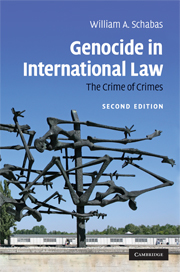Book contents
- Frontmatter
- Contents
- Preface to the first edition
- Preface to the second edition
- Acknowledgments
- List of abbreviations
- Introduction
- 1 Origins of the legal prohibition of genocide
- 2 Drafting of the Convention and subsequent normative developments
- 3 Groups protected by the Convention
- 4 The physical element or actus reus of genocide
- 5 The mental element or mens rea of genocide
- 6 ‘Other acts’ of genocide
- 7 Defences to genocide
- 8 Prosecution of genocide by international and domestic tribunals
- 9 State responsibility and the role of the International Court of Justice
- 10 Prevention of genocide
- 11 Treaty law questions and the Convention
- Conclusions
- Appendix: The three principal drafts of the Convention
- Bibliography
- Index
4 - The physical element or actus reus of genocide
Published online by Cambridge University Press: 07 July 2009
- Frontmatter
- Contents
- Preface to the first edition
- Preface to the second edition
- Acknowledgments
- List of abbreviations
- Introduction
- 1 Origins of the legal prohibition of genocide
- 2 Drafting of the Convention and subsequent normative developments
- 3 Groups protected by the Convention
- 4 The physical element or actus reus of genocide
- 5 The mental element or mens rea of genocide
- 6 ‘Other acts’ of genocide
- 7 Defences to genocide
- 8 Prosecution of genocide by international and domestic tribunals
- 9 State responsibility and the role of the International Court of Justice
- 10 Prevention of genocide
- 11 Treaty law questions and the Convention
- Conclusions
- Appendix: The three principal drafts of the Convention
- Bibliography
- Index
Summary
This chapter and the one that follows concern the two basic elements of the offence called ‘genocide’. Because genocide constitutes a criminal infraction, and because this study concentrates essentially on the law of genocide, a jargon familiar to criminal lawyers has been chosen for this discussion. To the criminal lawyer, the ‘elements of the offence’ are fundamental because they set out the ground rules of the trial, determining what must be proven by the prosecution for a case to succeed. If the prosecution establishes all the elements of the offence beyond a reasonable doubt (or the intime conviction) of the trier of fact, then a conviction may lie. If the defence casts reasonable doubt on even one ‘element of the offence’, then the accused is entitled to acquittal.
Criminal law analysis of an offence proceeds from a basic distinction between the physical element (the actus reus) and the mental element (the mens rea). The prosecution must prove specific material facts, but must also establish the accused's criminal intent or ‘guilty mind’: actus non facit reum nisi mens sit rea. The definition of genocide in the 1948 Convention invites this analysis, because it rather neatly separates the two elements. The initial phrase or chapeau of article II addresses the mens rea of the crime of genocide, that is, the ‘intent to destroy, in whole or in part, a national, ethnical, racial or religious group, as such’. The five subparagraphs of article II list the criminal acts or actus reus.
- Type
- Chapter
- Information
- Genocide in International LawThe Crime of Crimes, pp. 172 - 240Publisher: Cambridge University PressPrint publication year: 2009



